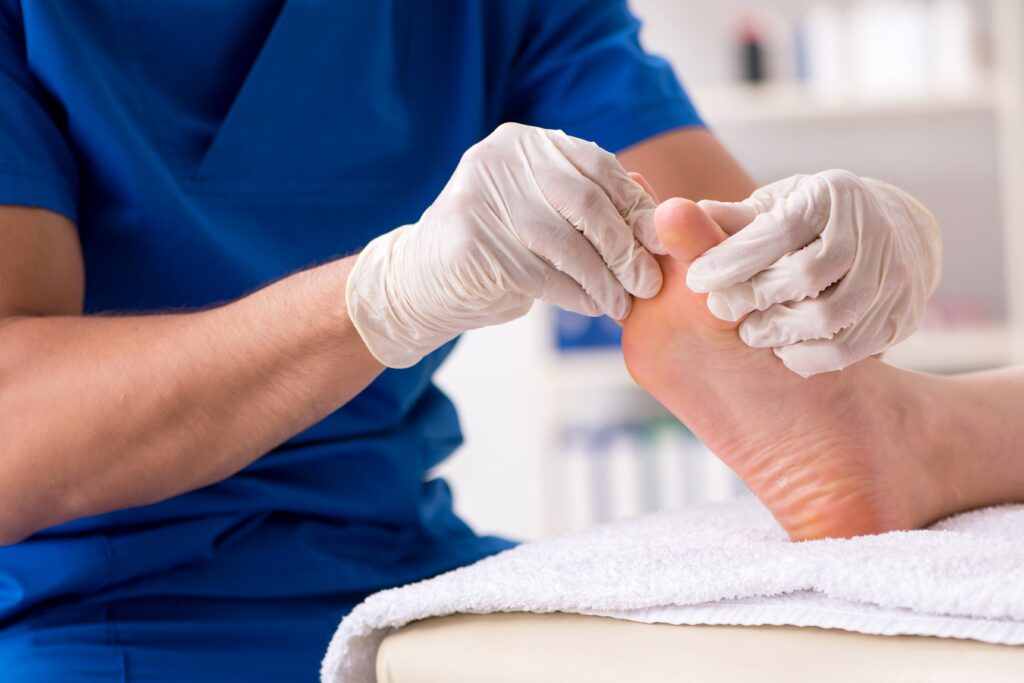Managing diabetes requires careful attention to more than just monitoring blood sugar levels; it also involves paying attention to your foot health. For individuals with diabetes, foot care is crucial to avoid complications that can lead to severe issues, including infection, ulcers, or even amputation. Our foot and ankle clinics in Edina and Burnsville cover diabetic foot care to help you keep your feet healthy year-round.
Why Diabetic Foot Care Matters
Diabetes can cause nerve damage (neuropathy) and poor blood circulation in the feet. When this happens, you may not feel pain from cuts, blisters, or sores, leading to untreated wounds that can become infected. Minnesota’s colder climate can also exacerbate circulation problems, increasing the risk of frostbite or other foot-related complications in the winter months. This is why proper diabetic foot care is essential to help you maintain mobility and quality of life.
Tips for Diabetic Foot Care
Inspect Your Feet Daily
Check your feet everyday for signs of cuts, blisters, redness, or swelling. The colder months in Minnesota can make skin dry and prone to cracking, so it’s crucial to check your feet regularly, even if you don’t feel pain.
Keep Your Feet Clean and Moisturized
Keeping your feet clean and hydrated is crucial as dry, cracked skin can lead to infections, Use a diabetes-friendly moisturizer, but avoid applying it between your toes to prevent any fungal growth.
Wear Proper Footwear
Invest in well-fitting shoes that protect your feet from injuries. During Minnesota’s colder months, opt for insulated, water-resistant shoes to keep your feet warm and dry. Diabetic shoes or inserts may also provide extra support and reduce the risk of developing pressure points or blisters.
Keep Your Feet Warm
Due to the colder climate in the winter, it’s essential to keep your feet warm without compromising circulation. Wear warm socks, but avoid those that are too tight as they can restrict blood flow. If you spend a lot of time outdoors, make sure your shoes provide enough insulation.
Trim Toenails Carefully
To prevent ingrown toenails and infections, trim your toenails straight across and file the edges gently. If you have trouble seeing or reaching your feet, consider visiting a podiatrist for regular nail care.
Avoid Walking Barefoot
Whether you’re at home or outside, always wear shoes or slippers. Walking barefoot increases the risk of cuts and injuries that you might not feel to neuropathy.
Manage Your Blood Sugar Levels
Maintaining healthy blood sugar levels is the best way to prevent foot complications. Poorly managed diabetes increases the risk of infection and slows the healing process. Work with your healthcare team to maintain balanced blood sugar levels.
Regular Podiatrist Visits
Schedule regular checkups with a podiatrist to catch any foot issues early. Your podiatrist can recommend specific treatments or footwear tailored to your needs.
When to See a Podiatrist for Diabetic Foot Care
If you notice any changes in your feet, such as numbness, sores that don’t heal, or any signs of infection, it’s time to visit a podiatrist. Early intervention can prevent minor foot problems from becoming serious. Regular foot screenings, especially for those with diabetes, can ensure that your feet remain healthy year-round. By following proper diabetic foot care practices and visiting your podiatrist, you can prevent more serious issues from occurring.


